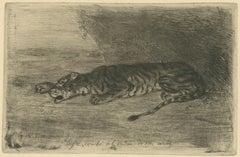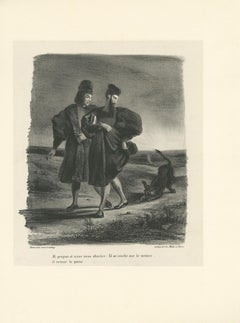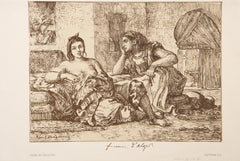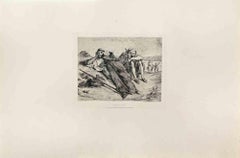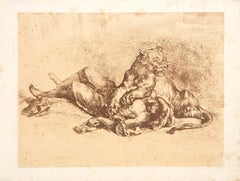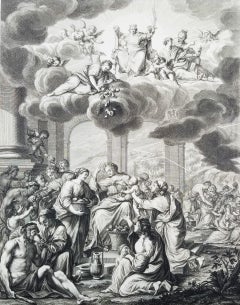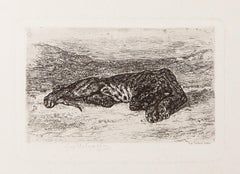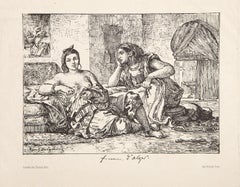Eugene Delacroix Art
French, 1798-1863
Ferdinand Victor Eugène Delacroix (French: 26 April 1798 – 13 August 1863) was a French Romantic artist regarded from the outset of his career as the leader of the French Romantic school.
In contrast to the Neoclassical perfectionism of his chief rival Ingres, Delacroix took for his inspiration the art of Rubens and painters of the Venetian Renaissance, with an attendant emphasis on colour and movement rather than clarity of outline and carefully modelled form. Dramatic and romantic content characterized the central themes of his maturity, and led him not to the classical models of Greek and Roman art, but to travel in North Africa, in search of the exotic. Friend and spiritual heir to Théodore Géricault, Delacroix was also inspired by Lord Byron, with whom he shared a strong identification with the "forces of the sublime", of nature in often violent action.
However, Delacroix was given to neither sentimentality nor bombast, and his Romanticism was that of an individualist. In the words of Baudelaire, "Delacroix was passionately in love with passion, but coldly determined to express passion as clearly as possible."Together with Ingres, Delacroix is considered one of the last old Masters of painting and is one of the few who was ever photographed.
As a painter and muralist, Delacroix's use of expressive brushstrokes and his study of the optical effects of colour profoundly shaped the work of the Impressionists, while his passion for the exotic inspired the artists of the Symbolist movement. A fine lithographer, Delacroix illustrated various works of William Shakespeare, the Scottish author Walter Scott, and the German author Johann Wolfgang von Goethe.to
6
4
Overall Width
to
Overall Height
to
8
2
1
4
3
6
4
9
6
4
4
3
2
1
1
1
1
1
1
6
4
2
1
1
10
8,780
2,809
1,652
1,313
5
3
Artist: Eugene Delacroix
Tigre couché à l'entrée de son antre (Tiger Lying at the Entrance to its Lair)
By Eugène Delacroix
Located in Middletown, NY
Etching, drypoint, and roulette on watermarked Hallines cream laid paper, 3 3/4 x 5 7/8 inches (95 x 148 mm), full margins. A very good impression of this charming image, with all of...
Category
Early 19th Century Realist Eugene Delacroix Art
Materials
Laid Paper, Drypoint, Etching
Faust, Méphistophélès et le Barbet / Faust, Méphistophélès and the Water Spaniel
By Eugène Delacroix
Located in Middletown, NY
Lithograph on Chine appliqué, 9 1/4 x 8 1/8 inches (235 x 206 mm), full margins. First state (of 4). Extremely minor uniform age tone, otherwise in good condition. A superb, richly-inked impression.
[Delteil 61.1]
______
At an early age Delacroix became a lover of music and literature and had been drawing from the time he entered school. He expected painting would be a hobby, but on the death of his father he found he had to make his own way in life. In 1817 he entered the studio of Pierre-Narcisse Guerin; amongst his fellow pupils was Gericault. His first exhibited work was Dante and Virgil...
Category
Early 19th Century Barbizon School Eugene Delacroix Art
Materials
Lithograph, Handmade Paper
Women of Algiers (color), Modern Lithograph by Eugene Delacroix
By Eugène Delacroix
Located in Long Island City, NY
Eugene Delacroix, French (1798 - 1863) - Women of Algiers (color), Year: 1838, Medium: Lithograph, Image Size: 6.25 x 8.75 inches, Size: 7.25 x 10.75 in. (18.42 x 27.31 cm), Publis...
Category
1830s Old Masters Eugene Delacroix Art
Materials
Lithograph
Arabes d'Oran - Etching by Eugene Delacroix - 1860s
By Eugène Delacroix
Located in Roma, IT
Arabes d'Oran is a black and White etching realized by E. Delacroix in the 1860s.
Titled in the lower.
Image size: 17x21.
Very good impression with wide margins and a very fresh ...
Category
1860s Modern Eugene Delacroix Art
Materials
Etching
The Italian Poet Tasso in the Madhouse - Etching
By Eugène Delacroix
Located in Paris, IDF
Eugène DELACROIX (1798-1863)
Tasso in the Madhouse
Engraving after a drawing
Signed on the plate
On vellum 38 x 50 cm
INFORMATION: In 1839, Delacroix painted his famous painting "T...
Category
Early 20th Century Modern Eugene Delacroix Art
Materials
Etching
Lionne Dechirant la Poitrine d'un Arabe, Modern Etching by Eugene Delacroix
By Eugène Delacroix
Located in Long Island City, NY
Eugene Delacroix, French (1798 - 1863) - Lionne Dechirant la Poitrine d'un Arabe, Year: 1849, Medium: Soft Ground Etching, signed and dated in the plate, Image Size: 8 x 10.75 inch...
Category
1840s Old Masters Eugene Delacroix Art
Materials
Etching
Un Forgeron - Etching by Eugène Delacroix - 1870s
By Eugène Delacroix
Located in Roma, IT
Un Forgeron is an artwork realized by Eugène Delacroix in the 1870s.
Etching.
Good conditions.
Realized for the "Société des Aquafortistes. Born on the initiative of the publisher...
Category
1870s Modern Eugene Delacroix Art
Materials
Etching
Surprise - Etching by François Chifflart - 1860s
By Eugène Delacroix
Located in Roma, IT
Surprise is a black and White etching realized by François Chifflart in the 1860s.
Titled in the lower.
Image size: 24x32.
Very good impression with wide margins and a very fresh...
Category
1860s Modern Eugene Delacroix Art
Materials
Etching
La Delivrance De La Princesse Olga - Etching by M.Roux after E. Delacroix - 1911
By Eugène Delacroix
Located in Roma, IT
Image dimensions: 24 x 28 cm.
La Delivrance De La Princesse Olga is an original print in etching technique on ivory-colored paper, realized by M. Roux after Eugène Delacroix .
In v...
Category
1910s Romantic Eugene Delacroix Art
Materials
Lithograph
Muletiers de Tetuan, Modern Lithograph by Eugene Delacroix
By Eugène Delacroix
Located in Long Island City, NY
Eugene Delacroix, French (1798 - 1863) - Muletiers de Tetuan, Year: 1833, Medium: Lithograph on Japon, Image Size: 8 x 10.5 inches, Size: 9.5 x 14 in. (24.13 x 35.56 cm), Publisher...
Category
1830s Old Masters Eugene Delacroix Art
Materials
Lithograph
Related Items
Meridies; Der Mittag (Noon; The Midday) /// Johann Daniel Preissler Old Master
Located in Saint Augustine, FL
Artist: (after) Johann Daniel Preissler (German, 1666-1737)
Title: "Meridies; Der Mittag (Noon; The Midday)"
Portfolio: Die Vier Tageszeiten (The Four Times of Day)
Year: 1723
Medium: Original Etching and Engraving on laid paper
Limited edition: Unknown
Printer: likely Johann Balthasar Probst, Augsburg, Germany
Publisher: Jeremias Wolff (Erben), Augsburg, Germany
Reference: Le Blanc No. 255, 38; Nagler No. 23
Sheet size: 22.5" x 16.32"
Image size: 18.13" x 14.32"
Condition: Soft handling creases and folds to sheet. A few light areas of staining and scattered small areas of discoloration in margins. Two small tears skillfully repaired from verso in margins. Has been professionally stored away for decades. It is otherwise a strong impression in good condition with full margins
Extremely rare
Notes:
Provenance: private collection - Aspen, CO. Engraved by German artist Johann Balthasar Probst (1673-1750) after a drawing by German artist Johann Daniel Preissler (1666-1737). Comes from Preissler's 1723 "Die Vier Tageszeiten (The Four Times of Day)" portfolio of four etchings and engravings. Printed from one copper plate in one color: black. Descriptions of the portrayed image are printed in Latin and German.
Biography:
Johann Daniel Preissler, or Preisler (1666–1737) was a German painter and director of Nuremberg's Academy of Fine Arts. He was a notable member of a German artistic family, originating in Bohemia. His children included Johann Justin Preissler (1698–1771), Georg Martin Preisler (1700–1754), Barbara Helena Preisler (1707–1758; married to Oeding), Johan Martin Preisler (1715–1794), and Valentin Daniel Preisler (1717–1765), all in their time renowned artists. Most notable for his portraits, nudes and history paintings, Johann Daniel Preissler also produced drawings and frescoes. He was particularly known beyond his native Nuremberg for his "Die durch Theorie erfundene Practic", a sequence of works on art theory – the individual works were translated into several other languages and served as textbooks for students such as the Swiss Salomon Gessner...
Category
1720s Old Masters Eugene Delacroix Art
Materials
Laid Paper, Engraving, Etching
$900
H 22.5 in W 16.32 in
Meditation and Minou
By Will Barnet
Located in Buffalo, NY
Artist: Will Barnet, American (1911 - 2012)
Title: Meditation and Minou
Year: 1980
Medium: Lithograph and Serigraph on BFK Rives, signed and numbered in pencil
Edition: 40/150
Category
1970s American Realist Eugene Delacroix Art
Materials
Archival Paper, Lithograph
The Crucifixion (Christ on the Cross) /// Jesus after Albrecht Dürer Old Masters
Located in Saint Augustine, FL
Artist: Lambrecht Hopfer (German, Active c. 1525-1550)
Title: "The Crucifixion (Christ on the Cross)"
Portfolio: (after) The Engraved Passion
*Issued unsigned, though monogram signed by Hopfer in the plate (printed signature) lower right
Circa: 1530 (second state of three, published c. 1690)
Medium: Original Etching on laid paper
Limited edition: Unknown
Printer: The Hopfer family, Augsburg, Germany; (David Funck, Nuremberg, Germany)
Publisher: The Hopfer family, Augsburg, Germany; (David Funck, Nuremberg, Germany)
Reference: Bartsch No. VIII.527.12; Hollstein No. 12.II
Framing: Recently framed, the sheet is floated over, and top-matted with a 100% cotton fabric rag mat from Holland in a wood moulding and Museum glass
Framed size: 14.88" x 13.88"
Sheet size: 5.5" x 3.63"
Condition: Trimmed to platemark. A few tiny professional repairs: at elbow of Jesus's right arm and the inside thigh of Jesus. Some light skinning upper right corner and lower right area. It is otherwise a strong impression in good condition
Very rare
Notes:
Provenance: private collection - Green Bay, WI; acquired from Sotheby's, New York, NY in c. 2015. The artist Lambrecht Hopfer's printed monogram signature "LH" lower right. The printer/publisher David Funck's (plate) number "182" lower right. This etching is after Albrecht Dürer’s 1511 engraving "The Crucifixion (Christ on the Cross)", ("Dürer-Katalog" - Meder No. 13, page 73). Printed in black from an iron plate. The image depicts Christ on the cross at center, the Virgin at left, two Maries behind her, St. John standing at right, a Roman solider behind him. It is after the eleventh plate of Dürer's sixteen plates from his 1507-1513 "The Engraved Passion" series, ("Dürer-Katalog" - Meder No. 3-18, page 70-74).
"The print was originally designed without the number engraved in the lower margin (First state: Lambrecht Hopfer, c. 1530). The Hopfers' descendant David Funck (Nuremberg, 1642–1705) acquired over two hundred of their original iron plates, engraved numbers into them, and re-printed them around 1686-1700. The "182" indicates that "The Crucifixion" was the 182nd print in Funck’s series (Second state: David Funck, c. 1686-1700). About a century later, 92 of these plates were acquired by Carl Wilhelm Silberberg in Frankfurt and printed for the third and final time in the book "Opera Hopferiana", of which "The Crucifixion" was the 90th print (Third state: Carl Wilhelm Silberberg for "Opera Hopferiana", 1802)". - Elizabeth Upper, Cambridge University Library, University of Cambridge, Cambridge, UK
Biography:
Lambrecht (Lambert) Hopfer (Active c. 1525-1550) was a German Old Masters printmaker. He was the brother of Hieronymus Hopfer (Active c. 1520-1530) and son of Daniel Hopfer...
Category
16th Century Old Masters Eugene Delacroix Art
Materials
Etching, Laid Paper
Vespera; Der Abend (Evening; The Evening) /// Johann Daniel Preissler Old Master
Located in Saint Augustine, FL
Artist: (after) Johann Daniel Preissler (German, 1666-1737)
Title: "Vespera; Der Abend (Evening; The Evening)"
Portfolio: Die Vier Tageszeiten (The Four Times of Day)
Year: 1723
Medium: Original Etching and Engraving on laid paper
Limited edition: Unknown
Printer: likely Johann Balthasar Probst, Augsburg, Germany
Publisher: Jeremias Wolff (Erben), Augsburg, Germany
Reference: Le Blanc No. 255, 38; Nagler No. 23
Sheet size: 22.5" x 16.63"
Image size: 17.38" x 13.63"
Condition: Soft handling creases and folds to sheet. Some scattered foxmarks in left margin. Two small tears skillfully repaired from verso in margins. Has been professionally stored away for decades. It is otherwise a strong impression in good condition with full margins
Extremely rare
Notes:
Provenance: private collection - Aspen, CO. Engraved by German artist Johann Balthasar Probst (1673-1750) after a drawing by German artist Johann Daniel Preissler (1666-1737). Comes from Preissler's 1723 "Die Vier Tageszeiten (The Four Times of Day)" portfolio of four etchings and engravings. Printed from one copper plate in one color: black. Descriptions of the portrayed image are printed in Latin and German.
Biography:
Johann Daniel Preissler, or Preisler (1666–1737) was a German painter and director of Nuremberg's Academy of Fine Arts. He was a notable member of a German artistic family, originating in Bohemia. His children included Johann Justin Preissler (1698–1771), Georg Martin Preisler (1700–1754), Barbara Helena Preisler (1707–1758; married to Oeding), Johan Martin Preisler (1715–1794), and Valentin Daniel Preisler (1717–1765), all in their time renowned artists. Most notable for his portraits, nudes and history paintings, Johann Daniel Preissler also produced drawings and frescoes. He was particularly known beyond his native Nuremberg for his "Die durch Theorie erfundene Practic", a sequence of works on art theory – the individual works were translated into several other languages and served as textbooks for students such as the Swiss Salomon Gessner...
Category
1720s Old Masters Eugene Delacroix Art
Materials
Laid Paper, Engraving, Etching
$900
H 22.5 in W 16.63 in
Aurora sive Tempus Matutinum; Der Wohl und Übel angewandte Morgen /// Old Master
Located in Saint Augustine, FL
Artist: (after) Johann Daniel Preissler (German, 1666-1737)
Title: "Aurora sive Tempus Matutinum; Der Wohl und Übel angewandte Morgen (Dawn or Morning Time; The Morning Used for Better or For Worse)"
Portfolio: Die Vier Tageszeiten (The Four Times of Day)
Year: 1723
Medium: Original Etching and Engraving on laid paper
Limited edition: Unknown
Printer: likely Johann Balthasar Probst, Augsburg, Germany
Publisher: Jeremias Wolff (Erben), Augsburg, Germany
Reference: Le Blanc No. 255, 38; Nagler No. 23
Sheet size: 22.57" x 16.38"
Image size: 17.75" x 14"
Condition: Soft handling creases, folds, and scattered faint areas of discoloration to sheet. Three tears skillfully repaired from verso. Has been professionally stored away for decades. It is otherwise a strong impression in good condition with full margins
Extremely rare
Notes:
Provenance: private collection - Aspen, CO. Engraved by German artist Johann Balthasar Probst (1673-1750) after a drawing by German artist Johann Daniel Preissler (1666-1737). Comes from Preissler's 1723 "Die Vier Tageszeiten (The Four Times of Day)" portfolio of four etchings and engravings. Printed from one copper plate in one color: black. Descriptions of the portrayed image are printed in Latin and German.
Biography:
Johann Daniel Preissler, or Preisler (1666–1737) was a German painter and director of Nuremberg's Academy of Fine Arts. He was a notable member of a German artistic family, originating in Bohemia. His children included Johann Justin Preissler (1698–1771), Georg Martin Preisler (1700–1754), Barbara Helena Preisler (1707–1758; married to Oeding), Johan Martin Preisler (1715–1794), and Valentin Daniel Preisler (1717–1765), all in their time renowned artists. Most notable for his portraits, nudes and history paintings, Johann Daniel Preissler also produced drawings and frescoes. He was particularly known beyond his native Nuremberg for his "Die durch Theorie erfundene Practic", a sequence of works on art theory – the individual works were translated into several other languages and served as textbooks for students such as the Swiss Salomon Gessner...
Category
1720s Old Masters Eugene Delacroix Art
Materials
Laid Paper, Engraving, Etching
$900
H 22.57 in W 16.38 in
Chicago Skyline
By Paul Schumann
Located in Middletown, NY
A beautiful turn-of-the-century lake view of Chicago by an American artist known for his Texas landscapes.
Etching with drypoint on watermarked Umbria laid paper with deckle edges, 7 1/4 x 10 7/8 inches (182 x 275 mm), full margins. Signed and numbered 4/25 in pencil, lower margin. In good condition with adhesive residue at the sheet edges on the verso, does not show through to the recto. A lovely Lake Michigan landscape...
Category
Early 20th Century American Modern Eugene Delacroix Art
Materials
Handmade Paper, Etching, Drypoint
The Princess after many years in the Glass Mountain by David Hockney fairy tale
By David Hockney
Located in New York, NY
This etching from David Hockney’s celebrated Six Fairy Tales from the Brothers Grimm portfolio depicts the somewhat obscure story Old Rinkrank, which Hockney chose to illustrate beca...
Category
1960s Modern Eugene Delacroix Art
Materials
Etching, Aquatint
$1,100
H 24.75 in W 17.75 in
The Matador.
By James McBey
Located in Storrs, CT
The Matador. 1911. Drypoint. Hardie 109. 6 7/8 x 10 7/8 (sheet 7 7/8 x 12). Edition 15. A few scattered foxing marks and slight mat line; otherwise fine o...
Category
1910s Modern Eugene Delacroix Art
Materials
Drypoint, Etching
Portrait de Femme (Portrait of a Woman) /// Old Masters Italian Romantic Queen
Located in Saint Augustine, FL
Artist: Pierre Augustin Massé (French, 1880-?)
Title: "Portrait de Femme (Portrait of a Woman)"
Portfolio: Gazette des Beaux-Arts
Year: 1898
Medium: Or...
Category
1890s Old Masters Eugene Delacroix Art
Materials
Etching, Aquatint, Intaglio
The West Prospect of the Cathedral of York /// "Britannia Illustrata" Engraving
By Johannes Kip
Located in Saint Augustine, FL
Artist: Johannes "Jan" Kip (Dutch, 1652/3-1722)
Title: "The West Prospect of the Cathedral of York" (Vol. 3, Plate 31)
Portfolio: Britannia Illustrata / Le Nouveau Théâtre de la Grande Bretagne
Year: 1715-1724 (Third edition)
Medium: Original Engraving and Etching on cream laid paper
Limited edition: Unknown
Printer: Joseph Smith, London, UK
Publisher: Joseph Smith, London, UK
Reference: "London Illustrated 1604-1850" - Adams No. 22; Crace No. 201; Brunet IV No. 114; Lowndes No. 1277; Lewine page 263-264
Sheet size: 19.25" x 24.19"
Image size: 16.75" x 22.5"
Condition: With centerfold as issued. Some light toning and foxing mainly in margins, and some light edgewear. Has been professionally stored away for decades. It is otherwise a strong impression in very good condition
Rare
Notes:
Provenance: private collection - Ross-on-Wye, UK. Engraved by Dutch artist Johannes "Jan" Kip (1652/3-1722) after a drawing by Dutch artist Leonard Knyff or Leendert Knijff (1650-1722). Comes from Kip's six volume (including Supplement and 'Atlas Anglois') "Britannia Illustrata" / Le Nouveau Théâtre de la Grande Bretagne", (1724-1728) (Third edition), which consists of 394 engravings and etchings. Printed in one color from one copper plate: black.
Biography:
Johannes "Jan" Kip (1652/53 in Amsterdam - 1722 in Westminster) was a Dutch draftsman, engraver and print dealer. Together with Leonard Knyff, he made a speciality of engraved views of English country houses.
Kip was a pupil of Bastiaen Stopendaal (1636–1707), from 1668 to 1670, before setting up on his own; his earliest dated engravings are from 1672. In April 1680, at the age of 27, he married Elisabeth Breda in Amsterdam. After producing works for the court of William of Orange in Amsterdam, Kip followed William and Mary to London and settled in St. John Street in Farringdon, where he conducted a thriving printselling business. He also worked for various London publishers producing engravings after such artists as Francis Barlow (c. 1626–1704) and Caius Gabriel Cibber (1630–1700), largely for book illustrations. He made several engraved plates for Awnsham & John Churchill's "A Collection of Voyages & Travels" (first published 1704). He signed the African scenes in volume V of the 1732 edition as "J. Kip".
His most important works were the large fold-out folio illustrations for "Britannia Illustrata", 1708; for the 65 folio plates he engraved for the antiquary Sir Robert Atkyns, "The Ancient and Present State of Glostershire", 1712 (1st edition); and for "Le Nouveau Théâtre de la Grande Bretagne ou description exacte des palais de la Reine, et des Maisons les plus considerables des des Seigneurs & des Gentilshommes de la Grande Bretagne", 1715, an extended reprint in collaboration with other artists.
The linked careers of Jan Kip and Leonard Knyff made a specialty of engraved views of English country houses, represented in detail from the bird's-eye view, a pictorial convention for topography. Their major work was "Britannia Illustrata: Or Views of Several of the Queens Palaces, as Also of the Principal seats of the Nobility and Gentry of Great Britain, Curiously Engraven on 80 Copper Plates", London (1707, published in the winter of 1708–9). The volume is among the most important English topographical publications of the 18th century. Architecture is rendered with care, and the settings of parterres and radiating avenues driven through woods or planted across fields, garden paths, gates and toolsheds are illustrated in detail. The images are staffed with figures and horses, coaches pulling into forecourts, water...
Category
1720s Old Masters Eugene Delacroix Art
Materials
Laid Paper, Engraving, Etching, Intaglio
20th century drypoint etching figurative animal print horses sketch signed
By Claude Weisbuch
Located in Milwaukee, WI
"Combat Equestre" is an original lithograph by Claude Weisbuch. The artist signed the piece lower right and wrote the edition number (24/100) in the lower left. This piece depicts mu...
Category
1970s Modern Eugene Delacroix Art
Materials
Drypoint, Etching
$4,050
H 27.25 in W 31.25 in
A Fierce Bull
By James McBey
Located in Storrs, CT
A Fierce Bull. 1911. Drypoint. Hardie 108. 5 3/8 x 8 (sheet 8 5/16 x 11 7/8). Edition 8. An exceptional impression with rich drypoint burr printed on antique laid paper. A proof of t...
Category
1910s Modern Eugene Delacroix Art
Materials
Drypoint, Etching
Previously Available Items
Tiger Sleeping in the Desert, Impressionist Etching by Eugene Delacroix
By Eugène Delacroix
Located in Long Island City, NY
Eugene Delacroix, French (1798 - 1863) - Tiger Sleeping in the Desert, Year: 1846, Medium: Etching, signed in the plate, Image Size: 3 x 4.75 inches, Size: 12.5 x 17.75 in. (31.75 ...
Category
1840s Impressionist Eugene Delacroix Art
Materials
Etching
Women of Algiers (B&W), Modern Lithograph by Eugene Delacroix
By Eugène Delacroix
Located in Long Island City, NY
Eugene Delacroix, French (1798 - 1863) - Women of Algiers (B&W), Year: 1838, Medium: Lithograph on Japon, Image Size: 6.25 x 8.75 inches, Size: 9.5 x 14 in. (24.13 x 35.56 cm), Pub...
Category
1830s Old Masters Eugene Delacroix Art
Materials
Lithograph
Faust and Mephistopheles Galloping on Walpurgis Night, Modern Lithograph
By Eugène Delacroix
Located in Long Island City, NY
Eugene Delacroix, French (1798 - 1863) - Faust and Mephistopheles Galloping on Walpurgis Night, Medium: Lithograph, Image Size: 8 x 11 inche...
Category
Mid-20th Century Modern Eugene Delacroix Art
Materials
Lithograph
Jeune Tigre jouant avec sa mère (Young Tiger playing with its mother)
By Eugène Delacroix
Located in Middletown, NY
Lithograph on on white wove paper, 4 1/2 x 7 3/8 inches (112 x 187 mm), wide margins. First state (of 6). A very good impression with minor scattered spots of very light discoloration.
[Delteil 91.1]
__________
At an early age Delacroix became a lover of music and literature and had been drawing from the time he entered school. He expected painting would be a hobby, but on the death of his father he found he had to make his own way in life. In 1817 he entered the studio of Pierre-Narcisse Guerin; amongst his fellow pupils was Gericault. His first exhibited work was Dante and Virgil...
Category
Mid-19th Century Barbizon School Eugene Delacroix Art
Materials
Lithograph, Handmade Paper
Theatrical Scene - Lithograph by Eugène Delacroix - 1843
By Eugène Delacroix
Located in Roma, IT
Theatrical Scene is an Lithograph realized after Eugène Delacroix in 1843.
Good condition on a yellowed paper.
Signed and dated on the lower right corner.
Ferdinand Victor Eugène Delacroix French: 26 April 1798 – 13 August 1863) was a French Romantic artist regarded from the outset of his career as the leader of the French Romantic school. As a painter and muralist, Delacroix's use of expressive brushstrokes and his study of the optical effects of colour profoundly shaped the work of the Impressionists, while his passion for the exotic inspired the artists of the Symbolist movement. A fine lithographer, Delacroix illustrated various works of William Shakespeare, the Scottish author Walter Scott and the German author Johann Wolfgang von Goethe.
Category
1840s Romantic Eugene Delacroix Art
Materials
Lithograph
H 17.52 in W 13.31 in D 0.04 in
Lion Dévorant un Cheval - Original Lithograph by E. Delacroix - 1844
By Eugène Delacroix
Located in Roma, IT
Lion dévorant un cheval is an original modern artwork realized by Eugène Delacroix (1798 - 1863) in 1844.
Original limited edition lithograph signed on plate.
Dimensions: 16.9 x 23.6 cm.
Very fine print on applied china, from the 4th state (out of 5), the title and date erased, before the Bertauts address and number erased.
Tiny redness and dirt on the support. Full margins.
Dry stamp: Contemporary Artists (Lugt 36b).
Very good conditions.
Eugène Delacroix (Charenton-Saint-Maurice, 1798 - 1863) was one of the leading artists of the French Romantic period in the 19th century. He received his artistic training in Paris and became known as a leading figure of the French Romantic era of the 19th century. Inspired by history, literature, and exotic locales, Delacroix painted such famous works as the "Liberty Leading the People...
Category
1840s Romantic Eugene Delacroix Art
Materials
Lithograph
H 6.66 in W 9.3 in D 0.04 in
Le Mise au Tombeau - Etching by E. Delacroix - 1859
By Eugène Delacroix
Located in Roma, IT
Image dimensions: 30x24 cm.
This splendid etching Le mise au tombeau was realized by Eugène Delacroix in 1859.
The state of preservation of the artwork is excellent. The artwork is handsigned on the lower left. At the bottom, just below the image, the inscriptions “Le mise au tombeau” in the center, "Marcel Roux...
Category
1850s Romantic Eugene Delacroix Art
Materials
Lithograph
H 17.13 in W 11.42 in D 0.08 in
Méphistophélès Dans les Airs - Lithograph by E. Delacroix - 1828
By Eugène Delacroix
Located in Roma, IT
Méphistophélès Dans les Airs " Mephistopheles in the Air", is an original lithograph, realized by Eugène Delacroix in 1828, table 1 by Goethe's Faust illustrated by Delacroix, Editor...
Category
1820s Romantic Eugene Delacroix Art
Materials
Lithograph
H 15.75 in W 12.6 in D 0.08 in
Herminie Et Les Bergers
By Eugène Delacroix
Located in Roma, IT
Original etching and aquatint by Eugène Delacroix named Herminie et Les Bergers. Perfect conditions. Printed by P. Fritel.
It represents an episode of Torqua...
Category
1830s Modern Eugene Delacroix Art
Materials
Etching
Study for Hercules Entre Le Vice et la vertu
By Eugène Delacroix
Located in Petworth, West Sussex
Ferdinand Victor Eugène Delacroix (French 1778 – 1863)
‘Study for Hercules Entre Le Vice et la vertu’
Pencil on paper, fan shape
Inscribed with atelier stamp ‘E.D’ (lower right)
...
Category
Early 19th Century Eugene Delacroix Art
Materials
Paper, Pencil
LION DEVORANT UN CHEVAL - Lion Devouring a Horse
By Eugène Delacroix
Located in Santa Monica, CA
EUGENE DELACROIX (1798 – 1863)
LION DEVORANT UN CHEVAL - Lion Devouring a Horse, 1844 (D.126 iv/v)
Lithograph on chine applique, signed in stone Eug. Delacroix. 6 5/8” x ...
Category
1840s Barbizon School Eugene Delacroix Art
Materials
Lithograph
Tiger
By Eugène Delacroix
Located in Saint Augustine, FL
An original etching by French artist Eugene Delacroix (1798-1863) titled "Tiger", 1883. Engraved by Auguste Boulard, Jr.. Limited Edition of 600. This etching was once exhibited at t...
Category
Late 19th Century Barbizon School Eugene Delacroix Art
Materials
Etching
Eugene Delacroix art for sale on 1stDibs.
Find a wide variety of authentic Eugene Delacroix art available for sale on 1stDibs. You can also browse by medium to find art by Eugene Delacroix in paper, lithograph, etching and more. Not every interior allows for large Eugene Delacroix art, so small editions measuring 6 inches across are available. Customers who are interested in this artist might also find the work of Hippolyte Bellangé, Nathaniel Currier, and James Ward. Eugene Delacroix art prices can differ depending upon medium, time period and other attributes. On 1stDibs, the price for these items starts at $132 and tops out at $18,912, while the average work can sell for $975.
Artists Similar to Eugene Delacroix
Questions About Eugene Delacroix Art
- 1stDibs ExpertJanuary 10, 2025Delacroix is considered a Romantic painter due to the era in which he worked and his artistic style. From the outset of his career in the early 19th century, he was regarded as the leader of the French Romantic school. In contrast to the neoclassical perfectionism of his chief rival, Jean-Auguste-Dominique Ingres, Eugène Delacroix took for his inspiration the art of Rubens and painters of the Venetian Renaissance, with an attendant emphasis on color and movement rather than clarity of outline and carefully modeled form. Dramatic and romantic content characterized the central themes of his maturity. Shop a collection of Eugène Delacroix art on 1stDibs.
